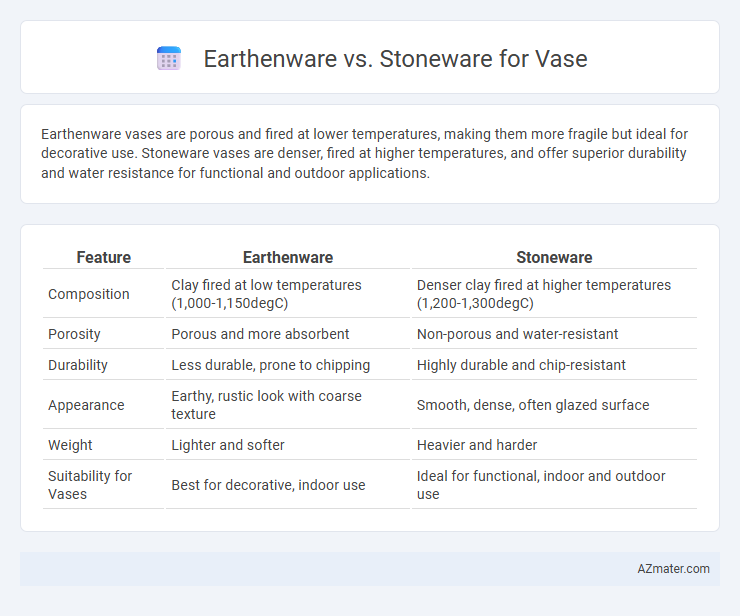Earthenware vases are porous and fired at lower temperatures, making them more fragile but ideal for decorative use. Stoneware vases are denser, fired at higher temperatures, and offer superior durability and water resistance for functional and outdoor applications.
Table of Comparison
| Feature | Earthenware | Stoneware |
|---|---|---|
| Composition | Clay fired at low temperatures (1,000-1,150degC) | Denser clay fired at higher temperatures (1,200-1,300degC) |
| Porosity | Porous and more absorbent | Non-porous and water-resistant |
| Durability | Less durable, prone to chipping | Highly durable and chip-resistant |
| Appearance | Earthy, rustic look with coarse texture | Smooth, dense, often glazed surface |
| Weight | Lighter and softer | Heavier and harder |
| Suitability for Vases | Best for decorative, indoor use | Ideal for functional, indoor and outdoor use |
Introduction to Earthenware and Stoneware Vases
Earthenware vases are crafted from porous clay fired at lower temperatures, resulting in a softer, more fragile material that is often glazed to prevent water absorption. Stoneware vases are made from denser clay fired at higher temperatures, producing a durable, non-porous surface ideal for both functional and decorative use. The choice between earthenware and stoneware vases depends on the desired aesthetic, durability, and intended use in home decor or gardening.
Material Composition: Earthenware vs. Stoneware
Earthenware vases are made from porous clay fired at lower temperatures between 1,000degC and 1,150degC, resulting in a softer, more porous material that requires glazing for waterproofing. Stoneware vases consist of denser, vitrified clay fired at higher temperatures from 1,200degC to 1,300degC, producing a harder, non-porous surface that is naturally more durable and chip-resistant. The difference in material composition affects the vase's strength, finish, and suitability for indoor or outdoor use.
Durability and Strength Comparison
Earthenware vases are porous and less durable, making them more susceptible to chipping and cracking compared to stoneware. Stoneware offers superior strength due to its higher firing temperature, resulting in a denser, non-porous surface that withstands impact and wear better. For long-lasting vases, stoneware is the preferred choice because of its enhanced durability and resistance to damage.
Porosity and Water Retention Differences
Earthenware vases exhibit higher porosity, making them more absorbent and less suitable for holding water without a glaze. Stoneware vases feature low porosity with dense, non-absorbent walls, allowing them to retain water effectively without leakage. The key difference lies in stoneware's vitrification process, which significantly reduces water absorption compared to the porous structure of earthenware.
Design and Aesthetic Appeal
Earthenware vases feature a porous texture and warmer, earthy tones that enhance rustic and traditional design styles, making them ideal for a cozy, natural aesthetic. Stoneware vases offer a denser, smoother finish with muted colors and subtle glaze variations, providing a more refined, contemporary look suitable for modern interiors. Both materials support diverse shapes and intricate patterns, but stoneware's durability allows for sharper detailing and a polished appearance that elevates sophisticated decor.
Weight and Handling
Earthenware vases are generally lighter and more porous, making them easier to handle but less durable compared to stoneware. Stoneware vases have a denser, heavier composition that provides increased strength and resistance to chipping or cracking. The weight and robust texture of stoneware contribute to its stability, especially for larger or outdoor vases, while earthenware is preferred for its lightweight and decorative appeal.
Glazing Options and Surface Finishes
Earthenware vases typically feature porous surfaces that require lead or salt glazing to achieve vibrant, glossy finishes, while stoneware offers a broader range of durable glazing options such as matte, satin, and high-gloss finishes due to its higher firing temperatures. The glazing on stoneware enhances resistance to scratching and chipping, making it ideal for both functional and decorative vases with varied textures, from smooth to heavily textured surfaces. Earthenware glazing often results in rustic, warm tones with a softer finish, contrasting the sleek, dense surface of stoneware vases that can mimic natural stone or metallic effects.
Price and Value Considerations
Earthenware vases typically cost less due to lower firing temperatures and porous clay composition, making them more affordable but less durable. Stoneware vases, fired at higher temperatures, offer increased strength and durability, often justifying their higher price with long-term value. When choosing between the two, consider that stoneware provides better resistance to chipping and water absorption, enhancing its functional lifespan despite the initial investment.
Best Uses: Earthenware or Stoneware for Vases
Stoneware vases are best for outdoor and high-use settings due to their durability and resistance to water and temperature changes. Earthenware vases excel in decorative indoor environments where their porous nature and delicate finish contribute to aesthetic appeal but require care to avoid moisture damage. For long-lasting functionality combined with rustic beauty, stoneware is the preferred choice, while earthenware suits artistic, low-maintenance displays.
Conclusion: Choosing the Right Vase Material
Earthenware vases offer a porous, lightweight, and affordable option ideal for decorative use and indoor plants, while stoneware vases provide superior durability, water resistance, and a dense, non-porous surface suitable for both indoor and outdoor settings. Selecting between earthenware and stoneware depends on the intended use, with stoneware preferred for longevity and resilience, and earthenware favored for aesthetic appeal and cost-effectiveness. Understanding factors like porosity, strength, and environmental exposure ensures the right vase material aligns with functional and stylistic needs.

Infographic: Earthenware vs Stoneware for Vase
 azmater.com
azmater.com